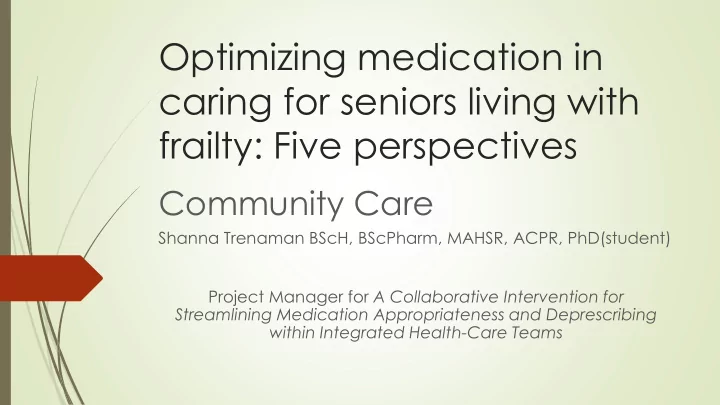

Optimizing medication in caring for seniors living with frailty: Five perspectives Community Care Shanna Trenaman BScH, BScPharm, MAHSR, ACPR, PhD(student) Project Manager for A Collaborative Intervention for Streamlining Medication Appropriateness and Deprescribing within Integrated Health-Care Teams
Objectives Attendees will gain insight and appreciation for the scope of polypharmacy and it’s significant impact on the care/outcomes of older adults living with frailty from five perspectives: community care , long-term care, acute care, cognitive impairment, and pharmacists. Attendees will learn about new work and evidence to address polypharmacy in these contexts leading to more optimal use of medications in treating the multiple/complex conditions inherent in living with frailty.
Frailty and Polypharmacy frequently co-exist Data from 909 individuals > 65 years of age followed in the NWAHS, a population representative longitudinal study of 4060 men and women aged ≥18 years. Participants were randomly selected from households in the north-west of metropolitan Adelaide, Australia and attended the clinic assessment at Stage 2 (2004 – 2006).
The state of polypharmacy in NS and NB Quality Indicators Explicit measures of medication appropriateness Implicit measures of medication appropriateness
Antipsychotics in those with Lewy Body Disease In NS Pharmacare beneficiaries with Parkinson’s disease or Lewy Body disease are prescribed antipsychotics (n=294) According to the STOPP criteria only clozapine and quetiapine are acceptable in someone with Parkinson’s disease or Lewy Body disease Clozapine or Other Atypical Typical Quetiapine Antipsychotics Antipsychotics
Long-term colchicine Gout is a painful inflammatory condition that affects older adults Colchicine dose is likely adequate at 1.2- 1.5 mg orally daily The first STOPP criteria (2008) stated long- term use of colchicine as potentially inappropriate prescribing Updated STOPP guidelines (2015) indicate potentially inappropriate prescribing of colchicine for durations >3 months.
NB experience - CFHI: Antipsychotics in Nursing Homes The problems with antipsychotic $1 • drugs: invested prevents not the best strategy for managing dementia $4.24 in health- associated with cognitive decline care can cause serious harm, including costs premature death Nation- • prescriptions are expensive wide associated complications are even program more expensive would 27.5 % of LTC residents were lower inappropriately prescribed falls by antipsychotic medication at least 20 % More than one in four people in long- term care who could benefit from AP reduction programs in New Brunswick
Two provinces with strong ties and different motivations A Collaborative Intervention for Streamlining Medication Appropriateness and Deprescribing within Integrated Health-Care Teams Melissa Andrew, MD, FRCPC, PhD Pamela Jarrett MD, FRCPC Jennifer Isenor PharmD Primary Care Clinic Nursing Home
What do the people want? A study in Quebec, Canada explored community-dwelling older individuals’ attitudes and perceptions towards deprescribing
What Do We Do Right Now Numerous tools exist that can be used to identify Potentially Inappropriate Medications (PIM) including; Beer’s list, STOPP/START, PRISCUS, LAROCHE, Medication Appropriateness Index (MAI), Drug Burden Index, Anticholinergic Drug Scale, Anticholinergic Cognitive Burden Scale, and numerous deprescribing tools from the Canadian Deprescribing Network The implementation of these tools is not as high as it could or should be So we have work to do
Research questions 1. What is the impact of the integration of the pharmacist and framework/tool on medication appropriateness, polypharmacy, cost of medications used, complexity of the drug regimen, the patient/caregiver quality of life, and number of emergency department visits or hospitalizations? 2. Is there differential effect of the intervention based on patient-specific characteristics such as frailty, age, sex & gender? 3. What are the barriers and enablers to the successful implementation of the tool from the perspectives of the pharmacists, prescribers and patients/caregivers?
Live Day, June 25, 26, 2018 Saint John, NB Topic A: Medications Topic B: Patients • How are we going to choose what drugs to • What patients to target? target? Do we select a list of drugs to target • Who is appropriate for deprescribing? or do we rely on expertise of pharmacists? • Is there an age limit? • Are there differences depending on whether • Is there a minimum level of frailty? a caregiver/patient chooses the medications • What about those taking specific medications? to eliminate versus the healthcare provider? Topic D: Evaluation and Communication • Topic C: Decision-Making Process How often should patients see the • What is the decision-making process? pharmacist? The physician? • • How are the deprescribing decisions made? How independent can/should pharmacist be? • • Who makes that decision? How can the tool be used to communicate • Will physician screen first and send to the information back to patients? The providers? • pharmacist? Should the pharmacist select Framework for communicating deprescribing patients? process with: patients and/or caregivers, with • Will the decision be made by medication use? those who prescribed the medications and other healthcare providers
Findings from our live day introduced by our patient advisors Remove age restriction Multiple methods of referral Toolbox
Timeline Phase 1: collaborative development of a framework and communication tool 1. Ways to identify a patient appropriate for deprescribing which will include frailty assessment 2. Ways to identify Potentially Inappropriate Medications 3. Ways to prioritize medications for deprescribing 4. Ways to discuss deprescribing with patients using a patient-centred process 5. Ways to communicate effectively with prescribers 6. A draft framework for deprescribing in our project 6. A draft tool for documenting and communicating progress through deprescribing with prescribers Three rounds of revisions remotely Phase 2 : implementation/pilot of the tool in three integrated primary healthcare teams and two nursing homes in NS and NB Phase 3 : evaluation of the tool by prescribers, pharmacists, and patients
Still to come Complete tool development Research Ethics at NSHA and Horizon Health Implementation (12 weeks) of tool in three integrated health teams January-April 2019 Implementation (12 weeks) tool in two LTCF January-April 2019 Data analysis April-June 2019 Final Reports July 2019
Questions Thank you for your attention Shanna Trenaman shanna.trenaman@dal.ca
Recommend
More recommend